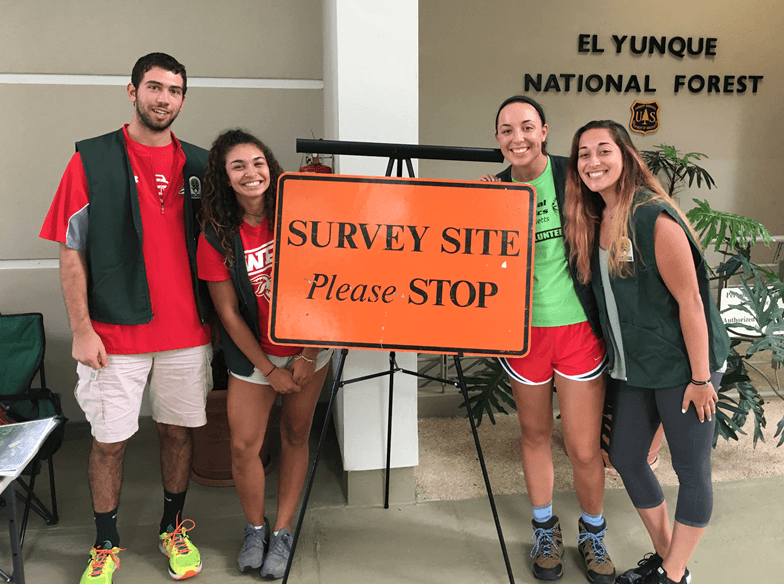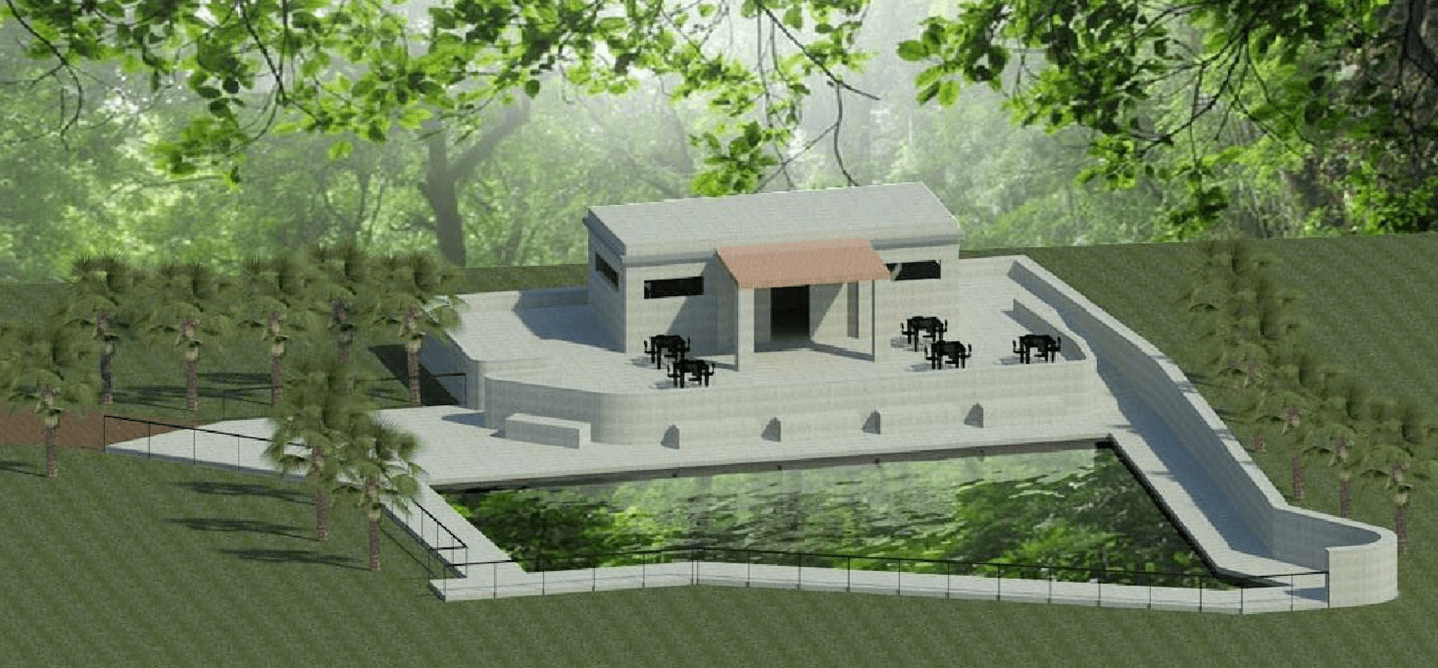Feasible Restoration Proposal of El Yunque National Forest Structures
 Sponsoring organization: United States Forest Service
Sponsoring organization: United States Forest Service
Team members: Morgan Maiola (Management Engineering ’18), Nina Murphy-Cook (Biology & Biotechnology ’18), Kayla Salmon (Civil Engineering ’18), Aaron Weeks (Mechanical Engineering ’18)
Download the final presentation.
Executive Summary: El Yunque is a popular destination for both tourists and locals, with an average of 1,250,000 people visiting per year. Roughly half of these visitors are Puerto Rican residents, the other half are people that visit from all over the world (USDA, 2013). As impressive as it might be to have a wide variety of tourism in the forest, there are disadvantages to accruing so much foot traffic within the forest each day. The forest spans 29,000 acres, yet people will visit the same popular spots causing localized congestion. With the restoration of old recreational structures, this would allow for dispersion of visitors and more of a variety of activities in El Yunque (Feliciano, 2016). The United States Forest Service (USFS), an agency that provides forest protection and resources for El Yunque, proposed to restore three sites: Baño Grande, Baño de Oro, and an old army barracks. These would be restored into new recreational sites that would help disperse the foot traffic in the forest, while also creating revenue. Restoration in the forest has been proposed in the past but has never been successfully completed. Our team has been brought in to work with the USFS to come up with a restoration plan for each structure that is feasible and pleasing to the public.
Methodology
In order to complete our project goal, we developed the following objectives:
- Find feasible uses for the structures
- Create a restoration plan and design while keeping the historical integrity
- Please the public and potential investors
- Allow for recreation expansion
To find feasible uses for the three structures in El Yunque, we began by surveying the sites. We assessed the land with field measurement tools to determine the different dimensions and amount of space each building had available before refurbishment could be done. We were also informed that we had to keep the historical integrity of each structure by preserving the feeling that the buildings bring and maintaining the structural aspects of each building. Once we assessed the areas we were working with, we created a large range of ideas of what these structures could be restored into, keeping in mind that the buildings should facilitate some form of recreation for the visitors of the forest. As the options were narrowed down, the ideas were presented to the public in the form of a survey. In both English and Spanish, we asked questions pertaining to each structure and what they would like to see happen to these structures in the future. We added background questions to find out information about how often they had been to the forest and whether they were residents or tourists. Along with surveying the public, we conducted interviews with the USFS employees of El Yunque National Forest to learn why proposed projects for these sites had not been carried out in the past and any other insight they had about the structures. Once that information was gathered, we analyzed the data and found the two most popular ideas for each structure, allowing us to develop restoration plans for each by conducting cost analyses. The cost analyses provided us with the information to determine which of the top two ideas were the most feasible and would obtain the attention of investors as well as community members. As the cost analyses were being conducted, sketch-ups in Autodesk programs were being created for our top idea for each of the structure sites. We designed a visual interpretation of how the restored structures would look. Once these renders were complete, they were part of the key deliverable of our final product, a pamphlet. The pamphlet included the feasibility analysis of each design, the revenue that could be generated from each idea, and the visual aids.
 Findings/Results
Findings/Results
Through evaluation of our survey, interview results, and cost analysis tables, we were able to develop our findings regarding the restoration process and the three structures.
Why proposed projects have not been successful in the past
After interviewing the staff of the USFS, we were able to gather information from multiple employees in different departments to determine why restoration projects such as ones regarding our specific structures have not been implemented in the past. Based on the discussions with these employees, prior management was a big factor in the halted progress of previously proposed projects. In any instance of an obstacle, the projects would be discontinued to avoid further issues. Recently there has been a change in higher management and both restoration and the revised Forest Plan are again a major aspect of what the USFS is aiming to work on to facilitate safety and recreation in El Yunque. Along with management, there has been a lack of follow up with projects when they are proposed. Not one person would be in charge of the restoration, resulting in the project being pushed aside and forgotten. Finally, a lack of funding has hindered any restoration plans being completed. No investors have put in money for the ideas, keeping them from even beginning.
The most feasible idea for the structures of Baño Grande
From the interviews, personal surveys, and online surveys, it was determined that a recreational swimming pool was the most favored idea for Baño Grande pool, followed by leaving the site as it is. For the Baño Grande bathhouse, the most favored ideas were a changing room to accompany the recreational swimming pool, or a cafe. For these four ideas, we then conducted a cost analysis. The cost analyses included estimations for plumbing, electric, materials, labor, construction, yearly expenses, revenue, and return on investment. From this, we determined the most economically viable option for both the pool and the bathhouse. For the pool, leaving it as a scenic viewing area was the most feasible option because it costs less to restore and is already a very popular location that people visit daily in the forest. There are also many hidden costs accompanied with reopening Baño Grande as a recreational swimming pool because there are many more safety standards that must be abided now compared to when the pool was in use many decades ago. For the bathhouse, the most feasible idea is to turn the building into a cafe that would be used regularly, as it is in a highly populated area of the forest. These ideas will generate the most revenue with little construction cost.
The most feasible idea for the structures of Baño de Oro
From the interviews, personal surveys, and online surveys, it was found that the most popular ideas for Baño de Oro pool were a wading pool or a flower garden, and for the Baño de Oro bathhouse, the most popular ideas were a concession stand or a flower exhibit to go along with and educate the public about the garden. With that information, we created cost analysis tables that broke down specific aspects needed for each idea which included plumbing, electric, materials, labor, construction, yearly expenses, revenue, and return on investment. After creating both tables for the pool and for the bathhouse, it was apparent that the most feasible option for the pool was to restore it into a wading pool, which can be paired with the bath house being made into a concession stand with changing rooms. These options in tandem with one another, will generate the most revenue with minimal construction costs.
The most feasible idea for the army barracks
From the interviews, personal surveys, and online surveys, it was found that the most favored ideas were the hotel and hostel for the army barracks. With that information, we created cost analysis tables that broke down specific aspects needed for each idea which included plumbing, electric, materials, labor, construction, yearly expenses, revenue, and return on investment. After creating the table, the hostel was the most feasible option between the two. Although it would make less money than the hotel, it requires less construction, and will not have to staff as many employees.
It is acknowledged that our procedures are not completely accurate. Our lack of time spent at the sites had some affect our results. We have minimal experience with surveying and interviewing, and have never calculated cost analyses before. The limited time given hinders the amount of surveys we were able to obtain, as well as the accuracy of our feasibility analyses. In addition to this, we were not present during the peak of the visitor season, so we were not able to obtain as much input. Readers of this paper should be aware of the limitations we faced in order to to gauge the credibility of our findings and the following recommendations.
Recommendations
Based on our findings and results, we have developed recommendations for each site, as well as where to go next with the project. These recommendations are purely suggestions based on our research and data:
Final ideas for each site
For each site, we recommend one final idea for restoration based on all our findings. For Baño Grande pool, we recommend cleaning the area and leaving it as is, creating a space that is more pleasing to the eye as a photo stop. For Baño Grande bathhouse we recommend that it be restored into a cafe because of the location and revenue it would incur. For Baño de Oro pool, we recommend restoring it back into a wading pool with handicap accessibility, and for Baño de Oro bathhouse we recommend it be restored into a concession area. Finally, for the army barracks, our recommendation is that the structure be restored into a hostel.
How to carry out construction
In order to carry out the restoration of each structure, we recommend that a local contractor be hired. They will have better access to workers as well as the materials needed to refurbish these spaces, as well as the leadership and knowledge to carry out these types of projects. Along with the contractor, we recommend hiring an architect and engineer to work together and optimize the results of each structure. Together, they will restore the structures into up to date buildings, while also keeping the historic integrity.
Where to start
Once the design plans are finalized, we recommend that the restoration begin at either Baño Grande or Baño de Oro, as these sites have less construction and involvement than the restoration of the army barracks. These are already well known and visited by forest goers, so starting the restoration there will begin to facilitate revenue while the plans for the army barracks are being created and third party investors and businesses are contacted.
Community involvement
At its current state, the community around El Yunque is separate from the forest itself which creates a divide. In order to facilitate community involvement, we recommend that the people in the community aid in the restoration projects. They would be able to help out with the beginning stages of restoration such as foliage removal and the painting of the structures. Once restoration is complete, the jobs that will be created through these new recreation structures can be given to community members. Jobs could potentially include working the concession, cleaning the pools, and lifeguarding. This will facilitate visitation to the sites as well as unity between the community and El Yunque National Forest.
Our suggestions, if implemented, can create a dynamic atmosphere of restoration in El Yunque. It will create recreation and revenue for the forest and it is our hope that the research and recommendations done by our team can impact the community as well as the economy of Puerto Rico in the future.


